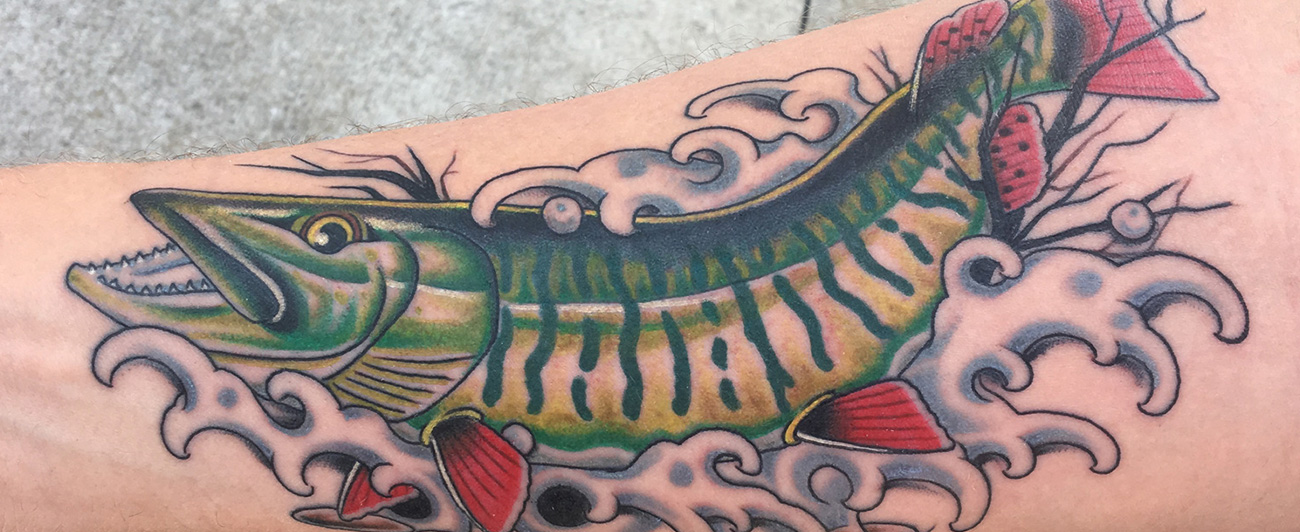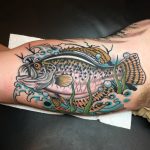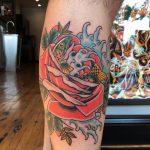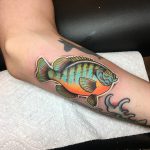Interview
Ink Fishing
An Interview with Tattoo Artist Drew Wilson
If you’ve ever scrolled #fishtattoo on Instagram, you’ve probably seen Drew’s work (@drewlr). His tattoos are vivid and bold, and because he freehands each one in marker before inking it in, each is truly one-of-a-kind.
His talent as an artist, and as a fly angler, has combined with his genuinely likeable demeanor to help him build quite a following. A native of Fayetteville, AR, Drew now spends a good portion of his time away from his home shop, touring the country. He guest tattoos at shops and conventions, always planning his routes around good trout water. Despite his love for the road, he says he’ll always call Fayetteville home.
Last year when he stopped by Salt Lake City during a multi-week trip, I had him ink a fingerling brown trout on my forearm. On his most recent trip to Utah we met up again. He’d just finished up with a client after several days of non-stop tattooing, and we grabbed a table at the dive pizza place next to the shop where he’d been working. Over slices dripping with grease and metal blaring on the stereo, we talked about trout art and trout fishing.
This interview has been edited for clarity.
above “After tattooing in Brooklyn for a couple days I was able to sneak up to the Catskills where my girlfriend and I met up with Kevin to fish for a day. He took us to a little mountain stream that was nothing but waterfalls separated by pools of brook trout. He took this photo of me setting up my Tufts and Batson bamboo 4 weight.” Photo: Kevin Mcllravy
The Flyfish Journal: What do you like so much about Fayetteville?
Drew Wilson: It’s a central hub. I can leave my house and I can be at the tattoo shop in six minutes in one direction. If I drive six minutes in the other direction I can be in a smallmouth stream. I’ve timed it. Six minutes, and I can have my feet wet. I’ve caught three-pound smallmouth out of that stream. I know there’s bigger ones in there. I’ve seen them. It’s cool that it’s that close.
What’s the percentage of fish tattoos now versus other stuff?
When I travel, it’s 100 percent fish tattoos. No one wants anything else from me when I’m on the road. When I’m at home it’s probably 20 to 30 percent fishing tattoos. My coworkers wouldn’t tell you that. They’d say it’s all I do.
Do you have any other specialties? Or is mostly flash stuff [pre-drawn tattoo art] people come in for?
Everybody wants to show you stuff on Pinterest. I do a lot of American traditional stuff. It’s the same style as the fish that I draw—a lot of panthers and wolves and stuff like that. Also, we do a walk-in Saturday where we just take whatever comes in the door. I do so many mountain ranges. Being in the Ozarks, it’s mountain ranges, arrows—standard white people stuff.
What’s your favorite species to tattoo?
It changes a lot. It changes based on what I’ve been doing a lot of. For a while I was doing these bluegill—they’re not actual bluegills—they’re just like a conglomeration of sunfish. I was like, “oh man these are the coolest. I want to do these.” And then I did a bunch of them and was like, “I want to do something else.”
I always like doing rainbow trout, because I think they just make good-looking tattoos. I think that they’re strong looking. For classic, bold-line tattooing, they are great. Brook trout are cool. I don’t know. It’s a hard question to answer. If you’d caught me on Wednesday, I’d have told you it was browns. If you caught me tomorrow it could be brook trout.
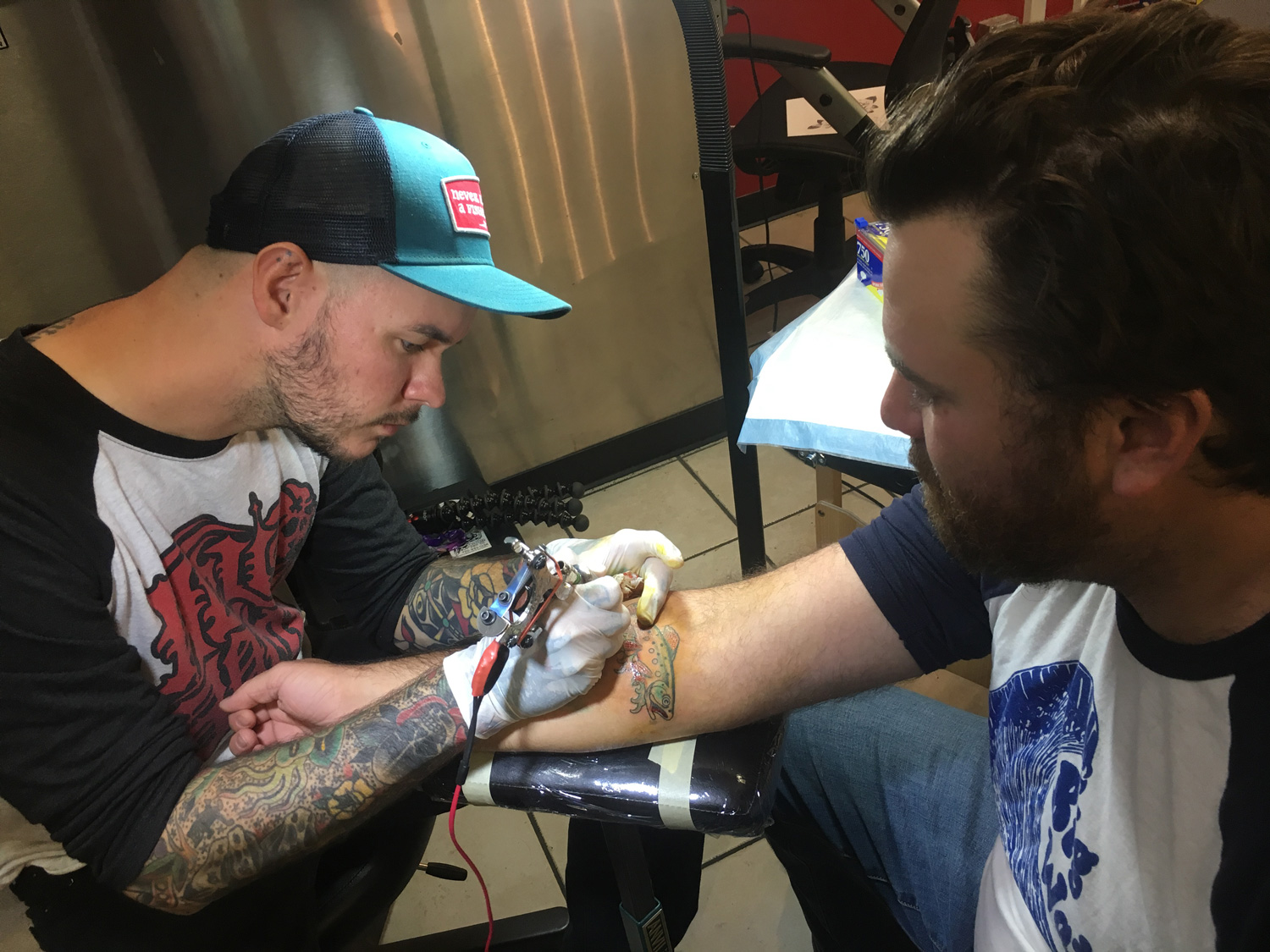
above Drew Wilson inks a fingerling brown trout on Colin Clancy at Lost Art Tattoo in Salt Lake City. Salt Lake was one stop of many on a multi-week road trip during which Drew tattooed and fished all across the West. Photo: Amy Clancy
What’s your favorite species to fish for?
It’s the exact same. I’ve got grass is greener syndrome. We get a super good striper run in Oklahoma, so I’ll go fish those. And the whole time I’ll be thinking that it’s almost hopper season. And when I’m fishing hopper season, I’m waiting for winter fishing. And once it’s winter fishing I’m waiting for smallmouth; as soon as smallmouth hit, I’m waiting for striper.
I’ve got such fond memories of certain things happening on certain rivers that I always want to have happen again, so I can never narrow down a favorite species. There are times of the year though that all I want to do is catch a certain thing. If there’s a fish in a river that’s not supposed to be there, like a smallmouth in a trout stream, that’s my favorite species, the one that you’re not supposed to be able to catch.
Which came first for you, the fishing or the art?
I was raised fishing. I’ve got home videos of me fishing when I was two years old. I’ve only been working in a shop for 12 years now, so I was definitely fishing the whole time. But I wasn’t fly fishing. I learned to fly fish at a summer camp in Texas when I was in sixth grade, but I didn’t touch a fly rod after that until I was probably 24.
I got a tattoo from a guy in Nashville, and I would get fishing lure tattoos because they were cheap. You could just get a $100 tattoo, collect stuff from different people. This guy, Mike Fite, he was such a prick to me because he was a flyfisherman, like an arrogant flyfisherman. And he shit-talked bass fishing to me. He wouldn’t tattoo a lure on me, only a fly. So, I left there and bought my first personal fly rod setup. I bought a combo at Bass Pro, because I was going to learn to flyfish to be better than this dude just to spite him. And that’s how I got into it.
You’ve said you didn’t get into art until the tattooing.
Yeah, my mom has pictures of me drawing and stuff when I was a kid, but I don’t ever remember doing art when I was a kid. I think I remember drawing some boobs when I was in eighth grade and thinking, wow those look alright!
But I didn’t even know how to draw until—I’m still learning, still learning every day actually. I shouldn’t say I know how yet.
I think you’re doing a pretty good job. When I came in to get tattooed, I was a little surprised that you just freehanded it with a Sharpie. Is that something you’ve always done?
It started about six months after I started doing a lot of fishing tattoos, because I felt like I’d drawn enough trout to understand how they needed to look, what their dimensions needed to be.
When I travel, also, you never know what kind of setup they’re going to have for printing and making stencils and things like that. So, in order to travel light it’s easy for me to buy a couple 15 packs of Sharpies. It also makes your client a little bit more submissive to your idea. When you’re drawing it on paper, a lot of times people nit-pick it halfway through. If you do it directly on their skin, they’re going to see how it fits them. You do a little yellow line with a Sharpie and see if the size works. And if they want it smaller, you do it smaller. That’s their bit of control, and everybody wants control of what they’re going to have on them forever.
I’ve wiped off five tattoos where someone didn’t like the design in the last four years. I’m lucky too, because most people who are coming to me are coming to me because of who I am now, and not just because I’m a tattoo shop. I get people who are passionate about fishing and they want to collect something from me rather than just get a fishing tattoo. So, drawing stuff on comes with that trust. Plus, I think it helps to show your client that you know how to draw and you’re not just tracing a trout in the back of the room, which happens a lot.
above left to right (click to expand)
This tattoo was made for Kent Holloway at Wilson’s home shop, Brainstorm Tattoo, in Fayetteville, AR. Photo: Drew Wilson
“This tattoo was drawn directly on the skin with sharpie to completely fill a gap for my client Garrett. It is, to date, the largest one-sitting fish tattoo I have done. That brown wraps up his arm and measures 14 inches from head to tail: an actual life size streamer eater.” Photo: Drew Wilson
“This fish was drawn on and tattooed at the Salt Lake City Tattoo convention earlier this year. Caleb drove up from Creede, CO, for the appointment, if I remember correctly. Conventions are often so busy and fast-paced that all the work begins to blend together.” Photo: Drew Wilson
It seems like wherever you go you catch huge fish.
I’m glad someone thinks that. I don’t feel that. I get pretty lucky. I just finished doing a tattoo a few minutes ago and the kid was talking to me about the exact same thing. And I told him that I think I’m just lucky, and I’d rather be lucky than skilled any day of the week.
But I do have a very handy tool for catching big fish places, and it’s Instagram. I was going to have a layover in Miami on my way to Brazil, a 21-hour layover. I posted something on Instagram saying, “anyone in Miami know anything about fishing in Miami? I just want to catch a fish while I’m in town.” I had someone pick me up at my hotel and take me to a flat, and I caught a bonefish on a layover.
In Xcalak, Mexico, a couple weeks ago, I was looking through Xcalak hashtags and found a picture of a kid holding a micro tarpon. I messaged him and asked him if he’d be interested in letting me know the area he was. He sent me a screenshot of a map with where he caught the fish circled, and I went there and caught a 25-pound tarpon on my third cast.
Having social media is a tool for fishing. It’s so silly that that’s how it is nowadays, but it’s not like these people are just giving it up—they’re not like: here’s a secret spot, just have it. They’re people who will go and fish with me, and they won’t usually take me to their golden water. They take me to a place that’s in the mid-range just to test me out to see if I can figure it out.
So, Instagram has affected your fishing life. How has it affected your life as a tattoo artist?
It’s made my fishing life and my life as a tattooer significantly easier. There are issues because I have to spend a lot of time on my phone, and I don’t necessarily enjoy that. But I worry every day that Instagram will crash and no one will want to get tattooed by me anymore, that’s how important it is. It’s so dumb that it’s like that, but it is. It’s so key.

above While filming a promo video for a local Fayetteville, AR, company called Fayettechill, photographer Aaron G. Copeland captures some of the work on display on Wilson’s own skin. Photo: Aaron G. Copeland
Your artwork stands out. If you look at a bunch of fish tattoos, yours have a distinctive style, and the colors somehow pop more. What makes your artwork different, and what are you trying to capture with it?
I learned to tattoo with interest in American traditional: bolder lines, generally brighter colors, enough black that it contrasts well. And you’re not counting on just the application—your design helps to make it strong.
You kind of answered this already, but what do you consider to be your home water?
The West Fork of the White River. It’s a little smallmouth creek. It’s got big fish in it, and the pools get sectioned in the summer—it dries out so you’ll have a deep pool, really shallow riffle—they’re not connected. When you find a hole that has a big fish in it, it’s going to be there for a while. If you don’t get him you can go back the next day. It’s a really easy place to hunt and target a large bass.
You’ve been posting on YouTube a little bit. It looks like your YouTube channel doesn’t have much to do with the tattooing.
Not at all.

above Couldn’t have said it better. The upper section of the White River, below the dam at beaver lake in Fayetteville, AR. Photo: Aaron G. Copeland
What’s your goal with it? What are you trying to accomplish with it?
My goal with that is just to make information that I get asked about regularly a little more available. I’ve got a little video about early season smallmouth fishing. It’s because every early season I start smallmouth fishing in March, and in Arkansas people don’t start until late May. When I start posting smallmouth pictures really early on, people start asking: “What are you doing? How are you doing it?” I wanted to make a video so that when people ask me those things, I can just send it to them and it won’t be hard for them to understand it because there’s a visual aid.
I like the idea of sharing fishing information harmlessly. It’s one thing to take someone to a secret spot and blow your place out, but it’s another thing to share technique. I don’t think there’s a problem with it. And if everyone catches on to one thing and it doesn’t work anymore, that should push you to learn something else.
What’s the coolest, most unexpected place you’ve ever fished?
Utah, where we’re at right now. Last year I came for the [Salt Lake City International Tattoo] Convention and did really well. Really, some of the most memorable stuff that I didn’t expect I’d get to fish was stuff that I was tipped off on through the internet. And I actually can’t talk about it. It’s places where [people say], “you should go here and you should fish this. Don’t pass up the opportunity, but please don’t tell anyone.”
I caught a 24-inch tiger a couple of years ago that was real fat, and it was in spawning colors, and it had this big old shovel kype on it that went probably an inch past its top lip. So that was cool, and I didn’t expect it, but I can’t say where it is. All the places that really stand out as awesome are all so secretive.
above left to right (click to expand)
“While on an eastern U.S. tattoo tour, I visited Trustworthy Tattoo in Oberlin, OH, and inked this on a guy named Alexander; the design is from a large poster I’d previously painted.” Photo: Drew Wilson
“I more or less generalize all sunfish, panfish and bluegills when tattooing them. I like to take my favorite parts of each and make a super panfish conglomerate. This tattoo was done for Ebin Bland, a return client of mine who has since become a fishing buddy. I have a tendency to walk ahead when fishing with others and he’s never given me a hard time about it, so he’s good by me.” Photo: Drew Wilson
What’s your most iconic tattoo design?
Those little mountain scenic trout, where it’s a trout with a mountain scene in it, have become the most popular thing I do. I don’t want that to be synonymous with me, because really in fish tattooing I like the idea of doing traditional tattoos that are of fish, or of goofy fun ideas or puns or something like that. While I’m always happy to do one of those scenes, I don’t want it to be my thing. I’d like to be known as a decent fisherman who does traditional tattoos of fish, and fun stuff.
What do you find most satisfying about the act of creating?
I have zero satisfaction in creating. It stresses me out so much. And every time I make something and get done with it I’m like, “OK, I can show this to the world now.” And I do, and then I have an idea to continue with it, but I’ve already shown it to the world. I just did a trout in a lava lamp and I made a sticker out of it, and some guy came and got it tattooed; but it wasn’t until a few weeks after I’d shown it that I was like, “man I should have put a bunch of midge larvae in there and called it a larvae lamp.”
And what do you find most satisfying about the act of fishing?
I do find a lot of validation from fishing whenever something that shouldn’t be easy happens for me easily. Like that little tarpon setup, where you catch a nice tarpon on your third cast. And I know that I could have done a better hook set on him, and I know that I probably could have led him better, and I know that luck was involved—so I’d rather be lucky. But even when you’re lucky, it’s still satisfying when you get something that’s difficult and it appears easy.
I used to think hook sets were satisfying because that meant that you tricked the fish; and I used to think that releases were satisfying because that meant that you had gotten what you needed and you were sending them back into the world. But now I feel satisfaction when I feel like I did something witty and it worked.
I feel the same in tattooing. If it’s witty and it works, and they didn’t see it coming, then that means I did it right. It’s always varying though; fishing will mean something different to me next year. It should change, I think.
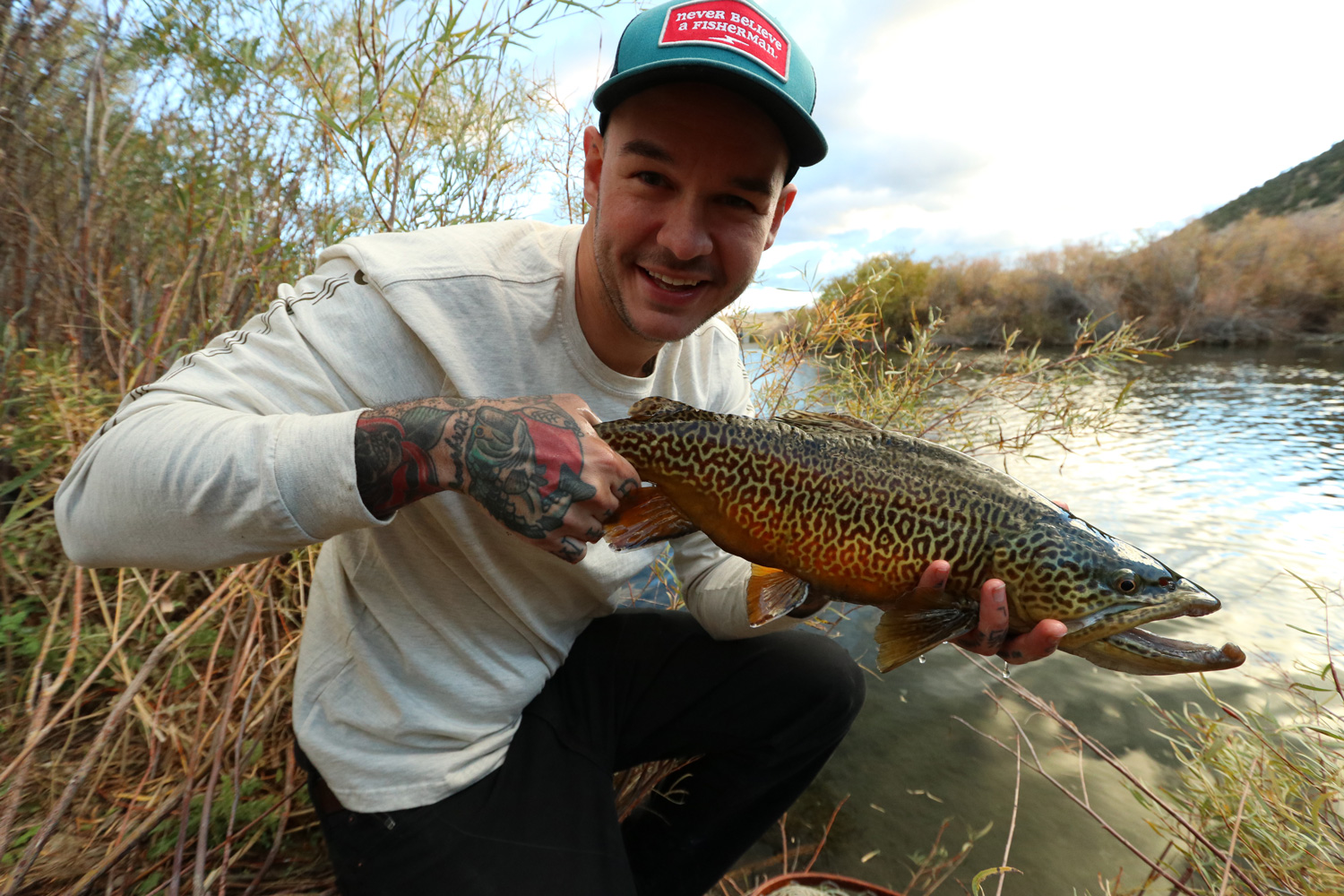
above “What a day. I was doing a western tattoo tour and had an extra day to fish between tattooing at Lost Art in Salt Lake City (the trip I tattooed Colin on) and working at Pale Horse in Reno, NV. We got tipped on a place where we might be able to catch some tiger trout without putting waders on. We don’t have tigers in the South, so I never pass up a chance to catch one—even though this was several hours out of the way. I sight-casted to a large white opening mouth I could see out in the deeper water, and this fish was the result. The best thing about doing fishing tattoos is that a lot of my clients are avid anglers and give me some great information.”
Photo: Katie Shingleur
